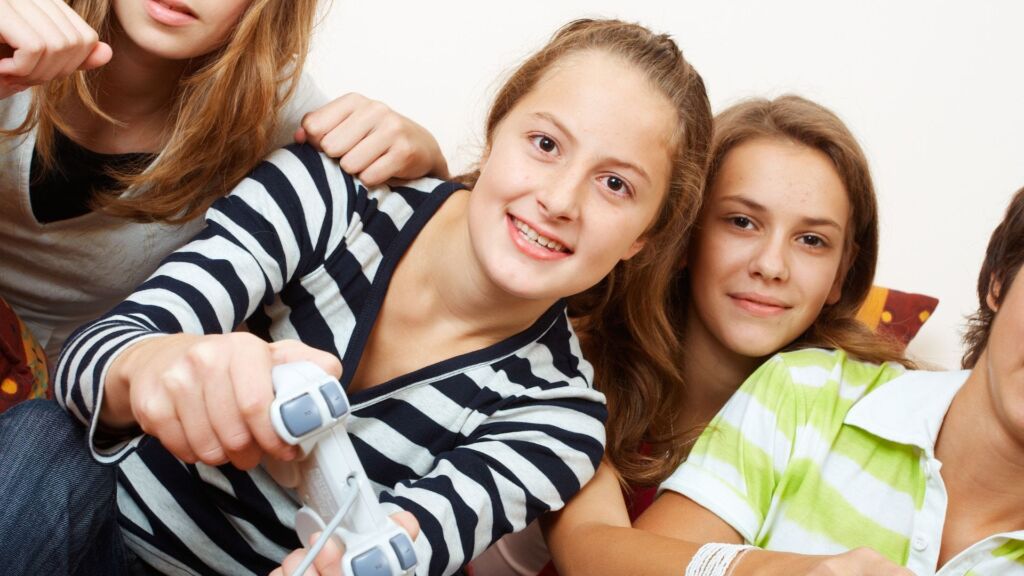Here’s how to set developmentally appropriate video game controls for tweens and teens that support the dynamic nature of a child’s growth.
KEY POINTS
- Effective digital parenting adapts to children’s maturing needs over time.
- Tweens benefit from structures that balance gameplay with diverse developmental activities.
- Young teens need a combination of independence and supportive parental guidance.
- Teach older teens to self-regulate through discussions and collaborative boundary-setting
If you have considered setting parental controls for your kids’ video games and gaming systems, the dizzying complexity of today’s gaming platforms can be overwhelming, making you hesitant to allow much video gameplay. Yet, as I wrote in a previous post, games can play important roles, with cognitive, emotional, and social benefits when played responsibly (Johannes et al., 2021; Orben & Przybylski, 2019). Are parental controls necessary? What is the right amount?Understanding the developmental stages that kids go through can help you set controls effectively. There are no magic ages when things happen. Just like when they learned to walk, every child matures differently. However, knowing the general flight plan can help you make better decisions about using parental controls in games and other forms of parental structure and guidance, like curfews and or personal hygiene.
This post includes:
- Gamers broken into three age groups: Tweens (10-13), Younger Teens (14-15), and Older Teens/Young Adults (16+).
- Descriptions of the significant cognitive and socio-emotional markers of each age group
- Suggestions for adapting video game parental controls to fit developmental needs as kids mature.
Developmental psychology provides a framework for understanding the changing cognitive, emotional, and social needs as kids grow. This insight is crucial because kids’ interactions with video games—or any media–are not static; they evolve as kids move through different stages of growth. Without considering these developmental milestones, you may not account for your child’s expanding capabilities and needs.
Stages of Cognitive and Psychosocial Development
The stages of cognitive and psychosocial development are interrelated, but each has a different focus. Cognitive stages refer to the formation of intellectual functions. These include all the ways people think, learn, and understand. It includes what gets noticed (attention), how people put things together to make meaning (logic and planning), and what they invent (imagination).
People aren’t born as mini-adults. Cognitive abilities change, sometimes unpredictably, in leaps and pauses as people grow and mature. Cognitive developmental stages are a way to conceptualize the ways these stages influence cognitive processes— how kids learn from and engage with the world and each other.
Psychosocial stages provide a framework for understanding human development’s more subjective and emotional side. This includes how people form a sense of self, develop an identity and personality, and recognize and learn to manage changing emotional and social needs.
Tweens (10-13)
Until the age of about 12, children think in very concrete ways. In the tween years, kids are developing more complex cognitive abilities, such as thinking logically and understanding complex tasks and emotions. During this period, children learn new psychosocial skills, such as taking initiative, being productive, and feeling pride in their accomplishments. This period of skills recognition and growing competencies is an essential foundation for self-esteem. Believe it or not, facing failures and overcoming challenges are important contributors to the development of self-efficacy and resilience.
Parental controls for the young end of this stage can shield tweens from inappropriate content that they don’t have the maturity to understand and set time limits to ensure that playtime doesn’t hinder educational or other activities that align with developmental tasks of this age, such as learning to follow rules and developing academic skills. At the older end of this stage, tweens bloom into teens. With this metamorphosis, they will gravitate toward social activities and increasingly feel the peer and social identity pressures that often compete with academic goals and parental demands.
Early Teen (14-15)
As children enter their early to mid-teens, they seek more independence, and their social circles expand. They continue to improve their ability to think systematically about logical relationships within a problem. Cognitive development continues through adolescence into young adulthood. Areas such as the prefrontal cortex that influence reasoning, self-regulation, and decision-making do not reach maturity until the mid-twenties. This explains why teens and even young adults can be impulsive, moody, and not very good at planning or making careful decisions.
Identity development is the primary psychosocial task of adolescence. Social relationships become increasingly important to teens as they provide the context for identity exploration. Teens are more likely to develop a strong positive identity if they feel valued and competent. Thus, they put a lot of energy and effort into behaviors they believe will help them feel accepted and fit in.
Parental controls can shift towards self-regulation, slowly relinquishing controls over schedules and time management as the teen demonstrates the ability to balance gaming and other responsibilities. More freedom to explore helps kids form their identities. To support this, parents can adapt controls to allow more social interactions within games. However, maintaining trust and open conversations is critical as the desire for independence and social connection may be more compelling than critical thinking and risk assessment skills. A trusting relationship lets you reinforce the importance of online safety, digital citizenship, and self-regulation without your kids becoming defensive. More importantly, an open and supportive relationship means you will be the go-to source if they run into trouble.
Late Teen/Young Adult (16+)
By the late teen years, kids are honing their abstract thinking and improving at future planning. As kids move between childhood and adulthood, they also develop moral frameworks. They begin to think about global concepts such as justice, social issues, and politics and develop idealistic views on specific topics or concerns. They are more vulnerable to the ideas of Influencers with whom they identify or admire, whether on TikTok or Twitch.
Gaming can be a meaningful refuge when it is kept in balance. Exercising skills in a game can bolster self-esteem. Games can provide opportunities to learn collaboration, conflict management, and negotiation skills. They also can be safe spaces to test their identities as emerging adults.
Teens may think they’re grown up, and it may seem like they don’t listen to parents, but they do. Parents remain the most impactful Influences in a teen’s life, and they want your approval and still need your support, help, and guidance. Try to view instances of bad judgment as valuable teaching moments. Nothing prepares kids better for leaving the nest than making some mistakes and learning from the consequences.

Photo: Vgajic/Getty Images
Setting Developmentally Appropriate Controls
Setting up parental controls doesn’t have to be a daunting task. Knowing your child is the first step to using parental controls that provide appropriate scaffolding without inspiring a hackathon or workaround. Remember, the goal isn’t to restrict your child. It is to empower good choices—enabling balanced, responsible, and enriching gaming experiences.
Ages 10-13: Setting Foundations
- Development: At this age, children are still developing their problem-solving and critical-thinking skills, taking initiative, and developing confidence.
- Recommended Controls:
- Limit playtime to encourage a balanced range of activities.
- Use cabined accounts to restrict access to certain games or features that may be too complex or inappropriate for young players.
- Be mindful of the growing need for initiative as the child matures. Being overly restrictive undermines opportunities to make mistakes and interferes with developing confidence.
- Examples:
- Minecraft’s adventure or creative modes can benefit cognitive development. However, consider limiting time spent in ‘Survival’ mode, which may contain more aggressive elements, particularly if your child suffers from anxiety.
- Games provide a continual feedback loop. Kids learn from failure in a game (like running out of lives) and continue to work and build the skills they need to reach the next level. Successful games reflect Csikszentmihalyi’s (1991) model for optimal engagement, called Flow, a balance of skill and challenge that makes gaming intrinsically rewarding.
Ages 14-15: Seeking Independence
- Development: Teens become more independent and better understand the consequences of their actions.
- Recommended Controls:
- Loosen some restrictions, like chat functions, but maintain periodic check-ins.
- Discuss in-app purchases and instilling a sense of financial responsibility.
- Examples:
- Games like Fortnite can provide an opportunity to discuss teamwork and strategy. Kids benefit from openness over in-game spending and clear rules about when purchases are OK and who’s paying.
Ages 16+: Preparing for Adulthood
- Development: Older teens are near adults and have well-developed cognitive functions but are still building self-regulation and emotional management skills.
- Recommended Controls:
- Discuss boundaries rather than setting them when possible, such as the amount of acceptable playtime.
- Talk about the themes and messages in games to help teens develop awareness of social stereotypes, manage emotional reactions to inappropriate content, and cope with hostile or aggressive behaviors like trash-talking.
- Examples:
- At this age, games like Call of Duty can be appropriate but should be accompanied by conversations about violence and its real-world implications.
- Role-playing games can also provide opportunities to experiment with identity in a low-risk environment.
There is No Such Thing As Perfect Parenting
Choosing the proper controls will depend on your kids’ cognitive and socio-emotional maturity. Using developmental psychology frameworks as guides, you can tailor parental controls to support their growth, not stunt their development. For younger children, more restrictive settings and close monitoring can be beneficial as boundaries and rules often make kids feel safer (and they can blame you for stuff they’re not allowed to do). As they mature, loosening these controls, accompanied by open dialogue, can foster a sense of responsibility and understanding. By being aware of your child’s developmental needs and the features offered by platforms and gaming systems, you can create a gaming environment that is not just safe but also enriching.
A final note.The cognitive and psychosocial development stages aren’t just for setting game controls. They will also give you insight into what’s happening inside a kid’s head. When I learned how brains change from tween to late teen, it kept me from taking a lot of my kids’ behaviors personally. I realized that the spontaneous emotional bursts, forgetfulness, social preoccupation, and irrational prioritizing weren’t a response to me or a result of my bad parenting. This vastly improved our relationships.
Also in this series from Dr. Pam, How and Why To Use Parental Controls in Video Games.
Want to keep up with Dr. Pam Rutledge? Sign up for her newsletter: https://drpam.substack.com.
This article also appeared on PsychologyToday.com.
References
Csikszentmihalyi, M. (1991). Flow: The psychology of optimal experience. HarperCollins Publishers.
Johannes, N., Vuorre, M., & Przybylski, A. K. (2021). Video game play is positively correlated with well-being. Royal Society Open Science, 8(2), 202049. https://doi.org/doi:10.1098/rsos.202049
Orben, A., & Przybylski, A. K. (2019). The association between adolescent well-being and digital technology use. Nature Human Behaviour, 3(2), 173-182. https://doi.org/10.1038/s41562-018-0506-1
Join Over 7,500 Fielding Alumni Located Around The World!
Change the world. Start with yours.™






Get Social